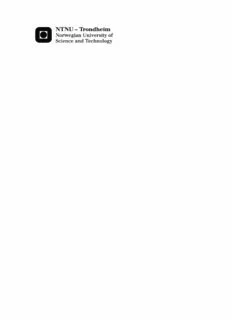Table Of ContentThink Aloud Methods with Eye Tracking in
Usability Testing
A comparison study with different task types
Terje Røsand
Master of Science in Informatics
Submission date: December 2012
Supervisor: Dag Svanæs, IDI
Co-supervisor: Øystein Nytrø, IDI
Norwegian University of Science and Technology
Department of Computer and Information Science
Preface
This endeavor is the result of my Master of Science study in informatics at the Department of
Computer and Information Science at the Norwegian University of Science and Technology - NTNU.
The project was done in conjunction with the Evicare project.
I would like to thank my main supervisor Dag Svanæs for his guidance throughout the project, and
my co-supervisor Øystein Nytrø for providing an interesting case.
I would also like to thank Zheng Wang, whom the experiment was designed in cooperation with. She
wanted to find out how reading clinical guidelines affect the decisions made by clinicians. She
collected her data by asking the participants to write down their “clinical questions” after task 2 and
task 3, and by a questionnaire regarding the clinical guideline.
Trondheim, December 20th 2012,
Terje Røsand
i
Abstract
The concurrent think aloud (CTA) method is perhaps the single most valuable usability engineering
method. The method has certain issues that may be avoided by using another method: Retrospective
think aloud (RTA). RTA can be conducted un-cued, or cued by different stimuli. Several studies have
been done to compare the different methods, but none of these have examined the methods under
different circumstances. In this study three different methods, CTA, RTA and RTAg (RTA cued by
video and gaze data) are compared when applied on three different task types: Easy interaction task,
reading task and complex problem solving task. The comparison was done in terms of four
measurements: Task performance, usability problems identified, amount of verbalization and the
participants’ subjective assessments. It was found that with the two retrospective methods there
were elicited more usability problems by means of verbalization as compared to CTA. It was also
found that during reading tasks and complex problem solving tasks the participants found it easier to
verbalize using RTAg than using RTA. Some observations were done that invite to further research.
iii
Sammendrag
Det å tenke høyt under brukbarhetstesting (concurrent think aloud – CTA) er sannsynligvis den mest
verdifulle enkeltstående metoden som brukes til å evaluere brukbarhet. Metoden har noen
svakheter som kan unngås ved å bruke en variant av metoden: Retrospective think aloud (RTA). Ved
bruk av RTA løser brukeren først oppgaven, og verbaliserer deretter I retrospekt. RTA kan brukes
uten noen hjelpemidler, eller det kan brukes forskjellige stimuli for å hjelpe brukeren med å
verbalisere. Det mest vanlige er å bruke en video der brukeren selv løser oppgaven. Det har blitt gjort
flere studier der ulike tenk høyt-metoder har blitt sammenlignet, men ingen studier der disse
metodene sammenlignes under foskjellige omstendigheter. Denne studien sammenlignes CTA, RTA
og RTAg (RTAg = RTA som bruker video og øyebevegelser som stimuli), når de brukes på oppgaver
som har forkjellige karakteristika: en enkel interaksjonsoppgave, en leseoppgave og en kompleks
broblemløsingsoppgave. Det ble målt gjennomføringstid og gjennomføringsrate for hver oppgave,
antall identifiserte brukbarhetsproblemer, antall ord verbalisert, og deltakernes subjektive
bedømmelse av hvordan de opplevde å bruke de ulike metodene. Det ble slått fast at de to
retrospektive metodene førte til identifikasjon av flere brukbarhetsproblemer gjennom verbalisering
I forhold til CTA. Det ble også konkludert med at testdeltakerne foretrekker RTAg når de løser en
leseoppgave eller kompleks broblemløsingsoppgave. Det ble gjort endel observasjoner som inviterer
til videre forskning.
v
Contents
Preface ...................................................................................................................................................... i
Abstract ................................................................................................................................................... iii
Sammendrag ............................................................................................................................................ v
Contents ................................................................................................................................................. vii
Figures ..................................................................................................................................................... xi
1 Introduction ..................................................................................................................................... 1
1.1 Background .............................................................................................................................. 1
1.2 Motivation and research questions ........................................................................................ 2
2 Usability and eye tracking ............................................................................................................... 5
2.1 Usability ................................................................................................................................... 5
2.2 Usability and user-centered design ......................................................................................... 5
2.3 Usability evaluation ................................................................................................................. 7
2.4 The usability laboratory at NSEP ............................................................................................. 8
2.5 Eye tracking ........................................................................................................................... 10
2.6 Motivation for research question ......................................................................................... 14
3 Method .......................................................................................................................................... 16
3.1 Experiment ............................................................................................................................ 16
3.1.1 Test object ..................................................................................................................... 17
3.1.2 Participants .................................................................................................................... 18
3.1.3 Tasks .............................................................................................................................. 19
3.1.4 Questionnaire ................................................................................................................ 21
3.1.5 Apparatus ...................................................................................................................... 21
3.1.6 Procedure ...................................................................................................................... 21
3.1.7 Conducting retrospective sessions ................................................................................ 24
3.2 Analysis .................................................................................................................................. 24
3.2.1 Processing empirical data .............................................................................................. 24
3.2.2 Statistical analyses ......................................................................................................... 26
4 Results ........................................................................................................................................... 27
4.1 Task completion time ............................................................................................................ 27
vii
4.2 Usability problems ................................................................................................................. 27
4.2.1 Usability problem P1 ..................................................................................................... 28
4.2.2 Usability problem P2 ..................................................................................................... 29
4.2.3 Usability problem P3 ..................................................................................................... 30
4.2.4 Usability problem P4 ..................................................................................................... 31
4.2.5 Usability problem P5 ..................................................................................................... 31
4.2.6 Instances of usability problems ..................................................................................... 32
4.3 Verbalization word count ...................................................................................................... 33
4.4 Participants’ subjective assessment ...................................................................................... 34
4.5 Qualitative observations ....................................................................................................... 37
4.5.1 Observations during retrospective sessions ................................................................. 37
4.5.2 Observations during CTA ............................................................................................... 37
5 Discussion ...................................................................................................................................... 38
5.1 Reactivity ............................................................................................................................... 38
5.1.1 Task completion time .................................................................................................... 38
5.1.2 Task completion rate ..................................................................................................... 38
5.2 Usability problems ................................................................................................................. 39
5.3 Insight .................................................................................................................................... 39
5.4 Task types .............................................................................................................................. 40
5.4.1 Easy interactive task ...................................................................................................... 40
5.4.2 Reading task .................................................................................................................. 40
5.4.3 Complex problem solving task ...................................................................................... 41
6 Conclusions .................................................................................................................................... 42
6.1.1 Why not just use CTA?................................................................................................... 42
6.1.2 RTA or RTAg? ................................................................................................................. 42
6.1.3 Limitations of this project.............................................................................................. 42
6.1.3.1 Usability problems ..................................................................................................... 42
6.1.3.2 Task characteristics ................................................................................................... 42
6.1.3.3 Insight ........................................................................................................................ 43
6.2 Further research .................................................................................................................... 43
7 References ..................................................................................................................................... 44
Appendix A – Php script .......................................................................................................................... A
Appendix B – Consent form ..................................................................................................................... B
Appendix C – Background and demographics form ................................................................................ C
Description:The concurrent think aloud (CTA) method is perhaps the single most In this study three different methods, CTA, RTA and RTAg (RTA cued by.

